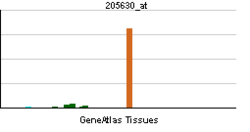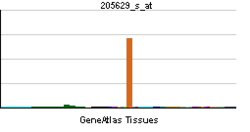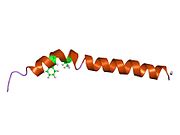- Corticotropin-releasing hormone
-
Corticotropin-releasing hormone (CRH), originally named corticotropin-releasing factor (CRF), and also called corticoliberin, is a polypeptide hormone and neurotransmitter involved in the stress response. It belongs to corticotropin-releasing factor family.
Its main function is the stimulation of the pituitary synthesis of ACTH.
Corticotropin-releasing hormone (CRH) is a 41-amino acid peptide derived from a 191-amino acid preprohormone. CRH is secreted by the paraventricular nucleus (PVN) of the hypothalamus in response to stress. Marked reduction in CRH has been observed in association with Alzheimer's disease, and autosomal recessive hypothalamic corticotropin deficiency[citation needed] has multiple and potentially fatal metabolic consequences including hypoglycemia and hepatitis. In addition to being produced in the hypothalamus, CRH is also synthesized in peripheral tissues, such as T lymphocytes, and is highly expressed in the placenta. In the placenta, CRH is a marker that determines the length of gestation and the timing of parturition and delivery. A rapid increase in circulating levels of CRH occurs at the onset of parturition, suggesting that, in addition to its metabolic functions, CRH may act as a trigger for parturition.[1]
Contents
Hormonal actions
CRH is produced by parvocellular neuroendocrine cells (which are contained within the paraventricular nucleus) of the hypothalamus and is released at the median eminence from neurosecretory terminals of these neurons into the primary capillary plexus of the hypothalamo-hypophyseal portal system. The portal system carries the CRH to the anterior lobe of the pituitary, where it stimulates corticotropes to secrete adrenocorticotrophic hormone (ACTH) and other biologically-active substances β-endorphin). ACTH stimulates the synthesis of cortisol, glucocorticoids, mineralocorticoids and DHEA; therefore high CRF levels are very common in individuals with Cushing's syndrome.
α-helical CRH-(9–41) acts as a CRH antagonist.[2]
Psychopharmacology
The CRH-1 receptor antagonist pexacerfont is currently under investigation for the treatment of generalized anxiety disorder in women.[3] Another CRH-1 antagonist antalarmin has been researched in animal studies for the treatment of anxiety, depression and other conditions, but no human trials with this compound have been carried out.
Also, abnormally high levels of CRH have been found in the cerebrospinal fluid of suicide victims.[4]
Recent research has linked the activation of the CRH1 receptor with the euphoric feelings that accompany alcohol consumption. A CRH1 receptor antagonist developed by Pfizer, CP-154,526 is under investigation for the potential treatment of alcoholism.[5][6]
Role in parturition
CRH is also synthesized by the placenta and seems to determine the duration of pregnancy.[7]
Levels rise towards the end of pregnancy just before birth and current theory suggests three roles of CRH in parturition:[8]
- Increases levels of dehydroepiandrosterone (DHEA) directly by action on the fetal adrenal gland, and indirectly via the mother's pituitary gland. DHEA has a role in preparing for and stimulating cervical contractions.
- Increases prostaglandin availability in uteroplacental tissues. Prostaglandins activate cervical contractions.
- Prior to parturition it may have a role inhibiting contractions, through increasing cAMP levels in the myometrium.
In culture, trophoblast CRH is inhibited by progesterone, which remains high throughout pregnancy. Its release is stimultated by glucocorticoids and catecholamines, which increase prior to parturition lifting this progesterone block.[9]
Structure
The 41-amino acid sequence of CRH was first discovered in sheep by Vale et al. in 1981.[10] Its full sequence is:
- SQEPPISLDLTFHLLREVLEMTKADQLAQQAHSNRKLLDIA
The rat and human peptides are identical and differ from the ovine sequence only by 7 amino acids.[11]
- SEEPPISLDLTFHLLREVLEMARAEQLAQQAHSNRKLMEII
See also
- Corticotropin-releasing hormone receptor
- ACTH
- Glucocorticoids
- Proopiomelanocortin
- Hypothalamic-pituitary-adrenal axis
- Corticorelin
- Cushing's syndrome
- Addison's syndrome
Interactions
Corticotropin-releasing hormone has been shown to interact with Corticotropin releasing hormone receptor 1.[12][13]
References
- ^ "Entrez Gene: CRH corticotropin releasing hormone". http://www.ncbi.nlm.nih.gov/sites/entrez?Db=gene&Cmd=ShowDetailView&TermToSearch=1392.
- ^ Santos J, Saunders PR, Hanssen NP, Yang PC, Yates D, Groot JA, Perdue MH (1 August 1999). "Corticotropin-releasing hormone mimics stress-induced colonic epithelial pathophysiology in the rat". Am. J. Physiol. 277 (2 Pt 1): G391–9. PMID 10444454. http://ajpgi.physiology.org/cgi/content/abstract/277/2/G391.
- ^ "Study of Pexacerfont (BMS-562086) in the Treatment of Outpatients With Generalized Anxiety Disorder". ClinicalTrials.gov. 2008-08-01. http://www.clinicaltrials.gov/ct/show/NCT00481325?order=31. Retrieved 2008-08-03.
- ^ Arató M, Bánki CM, Bissette G, Nemeroff CB (1989). "Elevated CSF CRF in suicide victims". Biol. Psychiatry 25 (3): 355–9. doi:10.1016/0006-3223(89)90183-2. PMID 2536563.
- ^ "Drug Has Potential To Prevent Alcoholics From Relapsing". Science News. ScienceDaily. 2008-08-02. http://www.sciencedaily.com/releases/2008/07/080730175518.htm. Retrieved 2008-08-09.
- ^ Pastor R, McKinnon CS, Scibelli AC, Burkhart-Kasch S, Reed C, Ryabinin AE, Coste SC, Stenzel-Poore MP, Phillips TJ (July 2008). "Corticotropin-releasing factor-1 receptor involvement in behavioral neuroadaptation to ethanol: a urocortin1-independent mechanism". Proc. Natl. Acad. Sci. U.S.A. 105 (26): 9070–5. doi:10.1073/pnas.0710181105. PMC 2449366. PMID 18591672. http://www.pubmedcentral.nih.gov/articlerender.fcgi?tool=pmcentrez&artid=2449366.
- ^ Kimball JW (2006-06-15). "Hormones of the Hypothalamus". Kimball's Biology Pages. http://users.rcn.com/jkimball.ma.ultranet/BiologyPages/H/Hypothalamus.html#CRH. Retrieved 2008-08-03.
- ^ Lye S, Challis JRG (2001). "Chapter 12: Parturition". In Bocking AD, Harding R. Fetal growth and development. Cambridge, UK: Cambridge University Press. pp. 241–266. ISBN 0-521-64543-3.
- ^ Jones SA, Brooks AN, Challis JR (April 1989). "Steroids modulate corticotropin-releasing hormone production in human fetal membranes and placenta". J. Clin. Endocrinol. Metab. 68 (4): 825–30. doi:10.1210/jcem-68-4-825. PMID 2537843.
- ^ Vale W, Spiess J, Rivier C, Rivier J (September 1981). "Characterization of a 41-residue ovine hypothalamic peptide that stimulates secretion of corticotropin and beta-endorphin". Science 213 (4514): 1394–7. doi:10.1126/science.6267699. PMID 6267699. http://www.sciencemag.org/cgi/pmidlookup?view=long&pmid=6267699.
- ^ Chrousos GP, Schuermeyer TH, Doppman J, Oldfield EH, Schulte HM, Gold PW, Loriaux DL (March 1985). "NIH conference. Clinical applications of corticotropin-releasing factor.". Annals of internal medicine 102 (3): 344–358. PMID 2982307. http://www.ncbi.nlm.nih.gov/pubmed/2982307.
- ^ Grammatopoulos, D K; Dai Y, Randeva H S, Levine M A, Karteris E, Easton A J, Hillhouse E W (Dec. 1999). "A novel spliced variant of the type 1 corticotropin-releasing hormone receptor with a deletion in the seventh transmembrane domain present in the human pregnant term myometrium and fetal membranes". Mol. Endocrinol. (UNITED STATES) 13 (12): 2189–202. doi:10.1210/me.13.12.2189. ISSN 0888-8809. PMID 10598591.
- ^ Gottowik, J; Goetschy V, Henriot S, Kitas E, Fluhman B, Clerc R G, Moreau J L, Monsma F J, Kilpatrick G J (Oct. 1997). "Labelling of CRF1 and CRF2 receptors using the novel radioligand, [3H]-urocortin". Neuropharmacology (ENGLAND) 36 (10): 1439–46. doi:10.1016/S0028-3908(97)00098-1. ISSN 0028-3908. PMID 9423932.
Further reading
- Florio P, Severi FM, Ciarmela P, et al. (2003). "Placental stress factors and maternal-fetal adaptive response: the corticotropin-releasing factor family". Endocrine 19 (1): 91–102. doi:10.1385/ENDO:19:1:91. PMID 12583606.
- Florio P, Rossi M, Sigurdardottir M, et al. (2003). "Paracrine regulation of endometrial function: interaction between progesterone and corticotropin-releasing factor (CRF) and activin A". Steroids 68 (10–13): 801–7. doi:10.1016/S0039-128X(03)00137-5. PMID 14667971.
- Vamvakopoulos NC, Karl M, Mayol V, et al. (1990). "Structural analysis of the regulatory region of the human corticotropin releasing hormone gene". FEBS Lett. 267 (1): 1–5. doi:10.1016/0014-5793(90)80272-K. PMID 2365075.
- Robinson BG, D'Angio LA, Pasieka KB, Majzoub JA (1989). "Preprocorticotropin releasing hormone: cDNA sequence and in vitro processing". Mol. Cell. Endocrinol. 61 (2): 175–80. doi:10.1016/0303-7207(89)90128-7. PMID 2783917.
- Arbiser JL, Morton CC, Bruns GA, Majzoub JA (1988). "Human corticotropin releasing hormone gene is located on the long arm of chromosome 8". Cytogenet. Cell Genet. 47 (3): 113–6. doi:10.1159/000132525. PMID 3259914.
- Sasaki A, Tempst P, Liotta AS, et al. (1988). "Isolation and characterization of a corticotropin-releasing hormone-like peptide from human placenta". J. Clin. Endocrinol. Metab. 67 (4): 768–73. doi:10.1210/jcem-67-4-768. PMID 3262120.
- Shibahara S, Morimoto Y, Furutani Y, et al. (1984). "Isolation and sequence analysis of the human corticotropin-releasing factor precursor gene". EMBO J. 2 (5): 775–9. PMC 555184. PMID 6605851. http://www.pubmedcentral.nih.gov/articlerender.fcgi?tool=pmcentrez&artid=555184.
- Behan DP, Heinrichs SC, Troncoso JC, et al. (1995). "Displacement of corticotropin releasing factor from its binding protein as a possible treatment for Alzheimer's disease". Nature 378 (6554): 284–7. doi:10.1038/378284a0. PMID 7477348.
- Kawahito Y, Sano H, Mukai S, et al. (1996). "Corticotropin releasing hormone in colonic mucosa in patients with ulcerative colitis". Gut 37 (4): 544–51. doi:10.1136/gut.37.4.544. PMC 1382908. PMID 7489943. http://www.pubmedcentral.nih.gov/articlerender.fcgi?tool=pmcentrez&artid=1382908.
- McLean M, Bisits A, Davies J, et al. (1995). "A placental clock controlling the length of human pregnancy". Nat. Med. 1 (5): 460–3. doi:10.1038/nm0595-460. PMID 7585095.
- Slominski A, Ermak G, Hwang J, et al. (1995). "Proopiomelanocortin, corticotropin releasing hormone and corticotropin releasing hormone receptor genes are expressed in human skin". FEBS Lett. 374 (1): 113–6. doi:10.1016/0014-5793(95)01090-2. PMID 7589495.
- Sutton SW, Behan DP, Lahrichi SL, et al. (1995). "Ligand requirements of the human corticotropin-releasing factor-binding protein". Endocrinology 136 (3): 1097–102. doi:10.1210/en.136.3.1097. PMID 7867564.
- Vamvakopoulos NC, Chrousos GP (1994). "Structural organization of the 5' flanking region of the human corticotropin releasing hormone gene". DNA Seq. 4 (3): 197–206. doi:10.3109/10425179309015632. PMID 8161822.
- Perrin MH, Donaldson CJ, Chen R, et al. (1994). "Cloning and functional expression of a rat brain corticotropin releasing factor (CRF) receptor". Endocrinology 133 (6): 3058–61. doi:10.1210/en.133.6.3058. PMID 8243338.
- Romier C, Bernassau JM, Cambillau C, Darbon H (1993). "Solution structure of human corticotropin releasing factor by 1H NMR and distance geometry with restrained molecular dynamics". Protein Eng. 6 (2): 149–56. doi:10.1093/protein/6.2.149. PMID 8386360.
- Liaw CW, Grigoriadis DE, Lovenberg TW, et al. (1997). "Localization of ligand-binding domains of human corticotropin-releasing factor receptor: a chimeric receptor approach". Mol. Endocrinol. 11 (7): 980–5. doi:10.1210/me.11.7.980. PMID 9178757.
- Timpl P, Spanagel R, Sillaber I, et al. (1998). "Impaired stress response and reduced anxiety in mice lacking a functional corticotropin-releasing hormone receptor 1". Nat. Genet. 19 (2): 162–6. doi:10.1038/520. PMID 9620773.
- Perone MJ, Murray CA, Brown OA, et al. (1998). "Procorticotrophin-releasing hormone: endoproteolytic processing and differential release of its derived peptides within AtT20 cells". Mol. Cell. Endocrinol. 142 (1–2): 191–202. doi:10.1016/S0303-7207(98)00104-X. PMID 9783915.
- Willenberg HS, Bornstein SR, Hiroi N, et al. (2000). "Effects of a novel corticotropin-releasing-hormone receptor type I antagonist on human adrenal function". Mol. Psychiatry 5 (2): 137–41. doi:10.1038/sj.mp.4000720. PMID 10822340.
- Saeed B, Fawcett M, Self C (2001). "Corticotropin-releasing hormone binding to the syncytiotrophoblast membranes". Eur. J. Clin. Invest. 31 (2): 125–30. doi:10.1046/j.1365-2362.2001.00770.x. PMID 11168450.
PDB gallery 1go9: MONITORING THE STRUCTURAL CONSEQUENCES OF PHE12-->D-PHE12 AND LEU15-->AIB15 SUBSTITUTION IN H/R CORTICOTROPIN RELEASING HORMONE: IMPLICATIONS FOR DESIGN OF CRH ANTAGONISTS.1goe: MONITORING THE STRUCTURAL CONSEQUENCES OF PHE12-->D-PHE12 AND LEU15-->AIB15 SUBSTITUTION IN H/R CORTICOTROPIN RELEASING HORMONE: IMPLICATIONS FOR DESIGN OF CRH ANTAGONISTS.Endocrine system: hormones (Peptide hormones · Steroid hormones) Endocrine
glandsTestis: testosterone · AMH · inhibin
Ovary: estradiol · progesterone · activin and inhibin · relaxin (pregnancy)
Placenta: hCG · HPL · estrogen · progesteroneIslet-Acinar
AxisNon-end.
glandsThymus: Thymosin (Thymosin α1, Thymosin beta) · Thymopoietin · Thymulin
Digestive system: Stomach: gastrin · ghrelin · Duodenum: CCK · GIP · secretin · motilin · VIP · Ileum: enteroglucagon · peptide YY · Liver/other: Insulin-like growth factor (IGF-1, IGF-2)
Adipose tissue: leptin · adiponectin · resistin
Kidney: JGA (renin) · peritubular cells (EPO) · calcitriol · prostaglandin
Heart: Natriuretic peptide (ANP, BNP)Peptides: neuropeptides Hormones see hormonesOpioid peptides OthersOther neuropeptides NeuromedinsOtherAngiotensin · Bombesin · Calcitonin gene-related peptide · Carnosine · Cocaine and amphetamine regulated transcript · Delta sleep-inducing peptide · FMRFamide · Galanin · Galanin-like peptide · Gastrin releasing peptide · Neuropeptide S · Neuropeptide Y · Neurophysins · Neurotensin · Pancreatic polypeptide · Pituitary adenylate cyclase activating peptide · RVD-Hpα · VGFB trdu: iter (nrpl/grfl/cytl/horl), csrc (lgic, enzr, gprc, igsr, intg, nrpr/grfr/cytr), itra (adap, gbpr, mapk), calc, lipd; path (hedp, wntp, tgfp+mapp, notp, jakp, fsap, hipp, tlrp) Neurotransmitters Amino acids Alanine · Aspartate · Cycloserine · DMG · GABA · Glutamate · Glycine · Hypotaurine · Kynurenic acid (Transtorine) · NAAG (Spaglumic acid) · NMG (Sarcosine) · Serine · Taurine · TMG (Betaine)
Endocannabinoids 2-AG · 2-AGE (Noladin ether) · AEA (Anandamide) · NADA · OAE (Virodhamine) · Oleamide · PEA (Palmitoylethanolamide) · RVD-Hpα · Hp (Hemopressin)
Gasotransmitters Monoamines Purines Trace amines 3-ITA · 5-MeO-DMT · Bufotenin · DMT · NMT · Octopamine · Phenethylamine · Synephrine · Thyronamine · Tryptamine · Tyramine
Others 1,4-BD · Acetylcholine · GBL · GHB · Histamine
Neuropeptidergics Cholecystokinin Agonists: Cholecystokinin • CCK-4
Antagonists: Asperlicin • Proglumide • Lorglumide • Devazepide • DexloxiglumideCRH Agonists: Corticotropin releasing hormoneGalanin Ghrelin MCH Agonists: Melanin concentrating hormone
Antagonists: ATC-0175 • GW-803,430 • NGD-4715 • SNAP-7941 • SNAP-94847Melanocortin Agonists: alpha-MSH • Afamelanotide • Bremelanotide • Melanotan II
Antagonists: Agouti signalling peptideNeuropeptide S Neuropeptide Y Neurotensin Opioid see Template:OpioidsOrexin Oxytocin Agonists: Carbetocin • Demoxytocin • Oxytocin • WAY-267,464
Antagonists: Atosiban • Epelsiban • L-371,257 • L-368,899Tachykinin Agonists: Substance P
Antagonists: Aprepitant • Befetupitant • Casopitant • CI-1021 • CP-96,345 • CP-99,994 • CP-122,721 • Dapitant • Ezlopitant • FK-888 • Fosaprepitant • GR-203,040 • GW-597,599 • HSP-117 • L-733,060 • L-741,671 • L-743,310 • L-758,298 • Lanepitant • LY-306,740 • Maropitant • Netupitant • NKP-608 • Nolpitantium • Orvepitant • RP-67,580 • SDZ NKT 343 • Vestipitant • VofopitantVasopressin Agonists: Desmopressin • Felypressin • Ornipressin • Terlipressin • Vasopressin
Antagonists: Conivaptan • Demeclocycline • RelcovaptanAgonists: Felypressin • Ornipressin • Terlipressin • Vasopressin
Antagonists: Demeclocycline • NelivaptanAgonists: Desmopressin • Ornipressin • Vasopressin
Antagonists: Conivaptan • Demeclocycline • Lixivaptan • Mozavaptan • Satavaptan • TolvaptanCategories:- Human proteins
- Hormones of the hypothalamus
- Peptide hormones
- Corticotropin-releasing hormone
- Hormones of the hypothalamus-pituitary-adrenal axis
Wikimedia Foundation. 2010.





